7 Tips for Designing a Jungle Habitat Room for Birds
Creating a jungle habitat for your birds is a fun adventure! Imagine them flying through a green paradise you built just for them. You’ll want at least 8 ft long and 4 ft wide for some serious flapping space.
Natural materials like logs and plants will set the scene. Add interactive perches and foraging spots, and your feathered friends will be entertained for hours. Don’t skimp on water and cozy shelters—it’s crucial for their well-being.
Speaking of unique creatures, let me tell you about my axolotl, Mr. Wiggles. He’s more than a pet; he’s part of my family! Caring for him taught me the importance of creating an inspiring environment, just like I do for my birds on my blog, ExoTails.
A Memorable Day With Mr. Wiggles
One morning, as I watched Mr. Wiggles waddle around, I realized how much joy he brings to my life. His little quirks, like pretending to be a ninja under the water, remind me how vital it is to provide an engaging habitat.
That day, I could almost hear him say, “Hey, I need some plants in here!” It clicked: a comfortable space promotes happiness in pets, be it birds or a silly axolotl. It’s all about creating a slice of their natural environment for their delight.
Quick Takeaways
- Select a spacious area that replicates a jungle environment, incorporating vertical space for flying and climbing.
- Use native plants and dense foliage to create natural shelters and food sources for birds.
- Incorporate interactive perches and natural structures for climbing and exploration opportunities.
- Design multiple feeding and water stations at varying heights to reduce competition and promote accessibility.
- Ensure comfortable nesting boxes and climate control features to maintain a healthy habitat.
Choose the Right Space for Open Flight
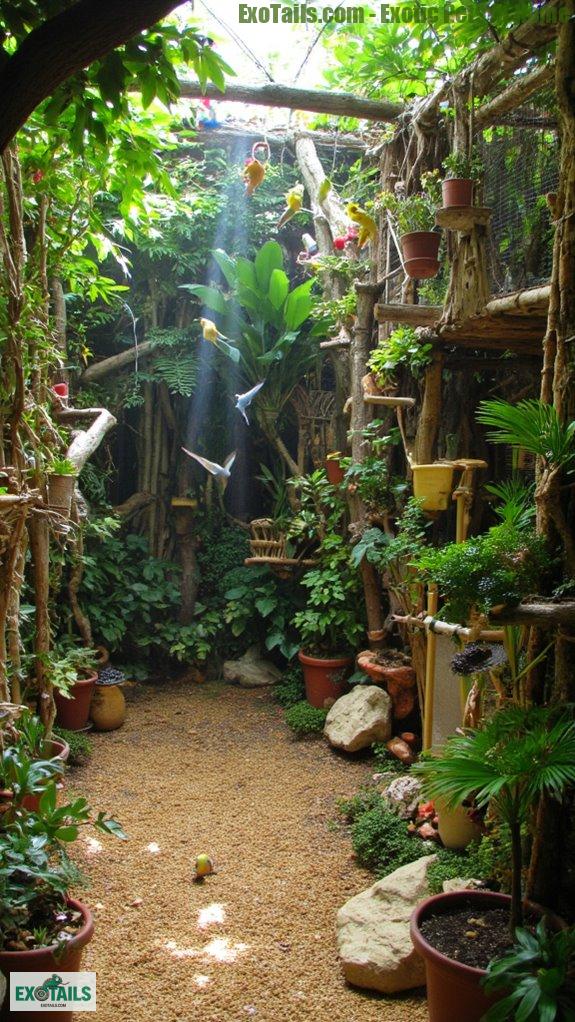
Have you ever wondered what it takes to create the perfect flying space for your feathered friends? Choosing the right aviary dimensions is essential for their safety and happiness.
For instance, a setup with 8 feet in length, 4 feet in width, and a towering 8 feet high can house around 20 budgies or cockatiels. It’s important to ensure that minimum dimensions are adhered to for each specific bird species to provide them with a comfortable environment. Additionally, including natural barriers can help simulate a more enriching experience for your birds.
Keep in mind, the flight area should ideally be 1.5 times their wingspan, allowing proper exercise.
Don’t overlook to check local regulations, too! I learned this the hard way.
Incorporate Natural Materials and Vegetation
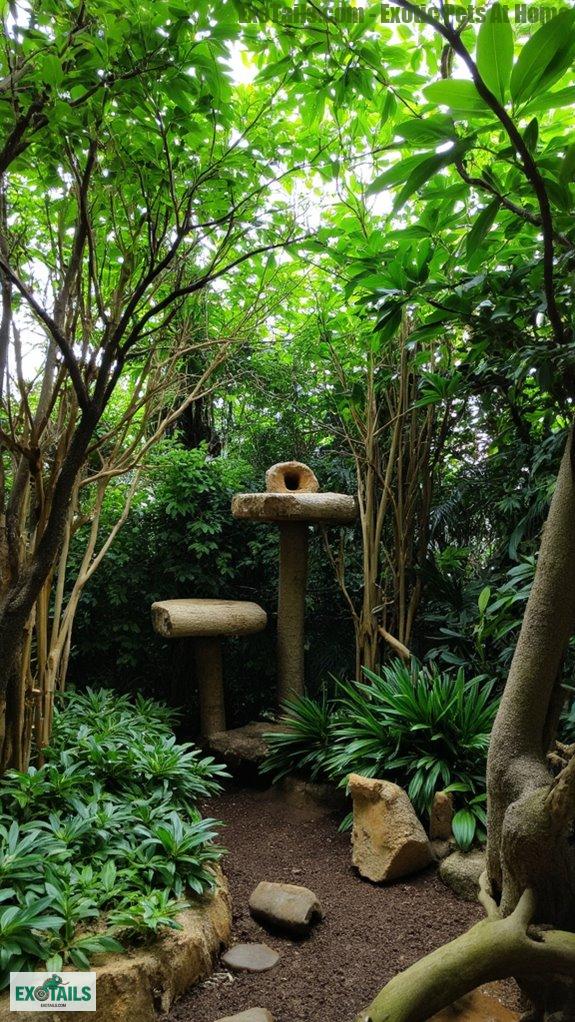
Creating a lively and vibrant habitat goes beyond just selecting the right space for your feathered friends to stretch their wings; it also involves bringing the natural world into your aviary. To do this, think about:
- Choosing native plants for reliability and authenticity
- Implementing vegetation layering for shelter and food, which can also attract a wider variety of bird species.
- Adding natural structures like logs for perches, which provide essential support and naturalistic environments for your birds.
- Including dense foliage to shield against predators
- Crafting microhabitats with branches and leaves
Design Enrichment Features for Exploration

When it comes to designing enriching features for birds, the joy is in the details—think of it as setting up an adventurous playground that keeps your feathered pals engaged.
Interactive perches of various sizes let your birds climb and explore, while sensory enrichment from textures adds excitement.
Don’t forget foraging opportunities—hidden treats mimicking nature keep them busy.
Rotating toys adds novelty, ensuring your birds stay curious and active.
Incorporating nature-inspired color palettes into your design not only enhances aesthetics but also creates a harmonious environment.
Trust me, incorporating these features not only encourages natural behaviors but makes your jungle habitat a thrilling place for exploration.
After all, who doesn’t want happy, entertained birds?
Provide Ample Feeding and Water Stations
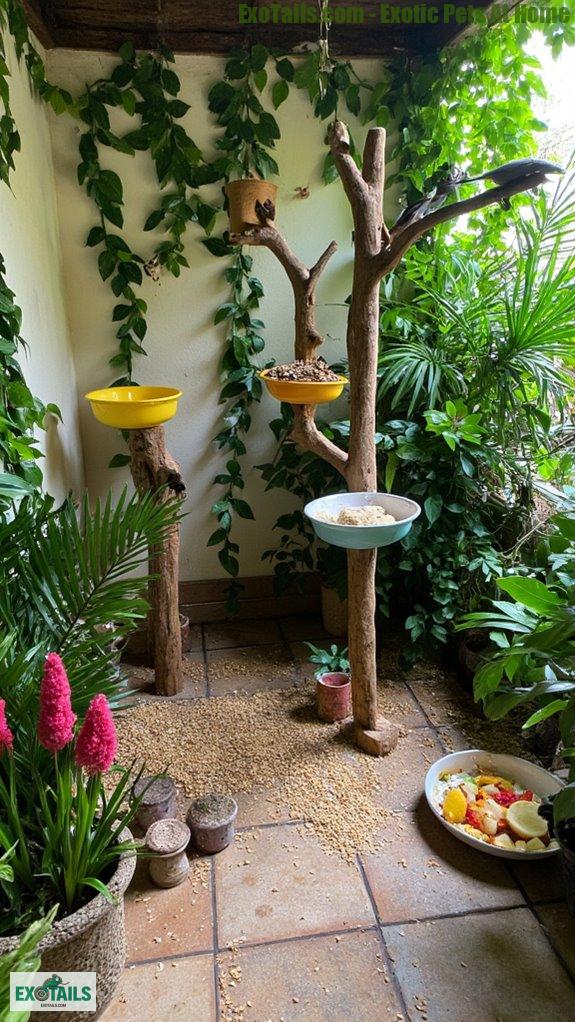
Since birds can’t exactly order takeout or hit up a nearby café, it’s essential to provide ample feeding and water stations in their jungle habitat.
These must be strategically placed for safety and comfort.
Here are some tips to get it right:
- Secure feeding bowls to prevent spills.
- Mix feeder heights for different birds.
- Install multiple water sources to keep competition low.
- Use shallow baths, avoiding drowning risks.
- Clean leftovers daily to fend off bacteria.
Creating a safe feeding environment is like setting the perfect table for a fancy dinner party—just without the tuxedo!
Ensure Proper Shelter and Climate Control
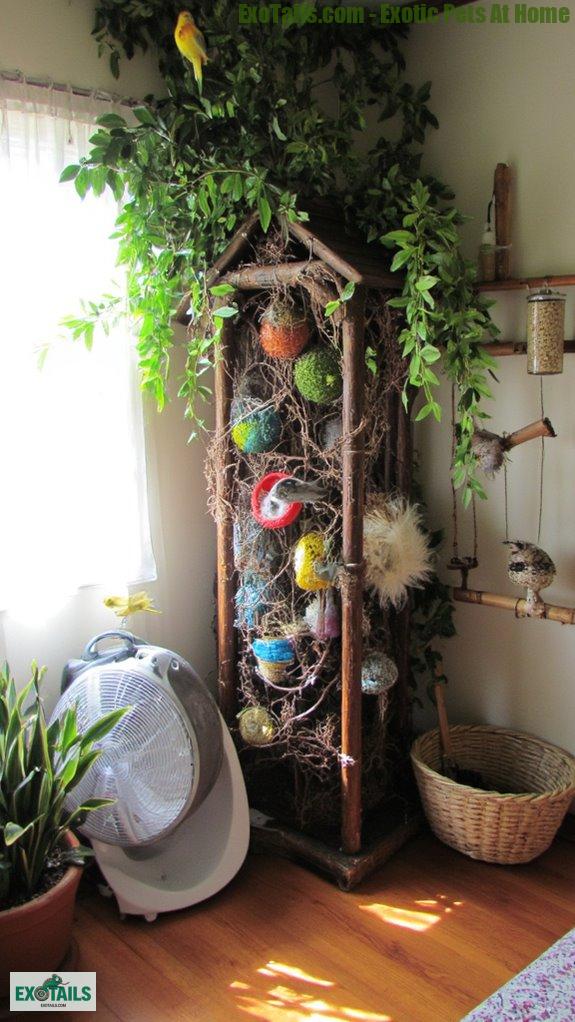
Feeding and watering our feathered friends is just the beginning of creating a vibrant jungle habitat—shelter and climate control play a key role too!
When it comes to shelter design, think durable materials that can brave the elements. I’ve learned to include cozy nesting boxes, perfect for snuggling and breeding.
And don’t forget climate monitoring! Keep temperature and humidity in check, using fans or humidifiers as needed.
Do your birds love fluttering around? Make sure they’ve enough space to spread their wings!
Creating a safe oasis guarantees they thrive, and let’s face it, happy birds make for some seriously entertaining company! Additionally, providing a variety of proper food options ensures that your birds receive essential nutrients to stay healthy.
Maintain Safety and Security Measures

Creating a safe and secure environment for our feathered companions isn’t just good practice; it’s essential for their happiness and well-being.
Trust me, I’ve been there, and I’ve learned a thing or two about keeping our colorful friends protected!
Here are some key security measures I recommend:
- High-quality enclosures with robust mesh netting
- Secure doors with high-tensile steel padlocks
- Alarm systems equipped with motion detectors
- Regular security drills for staff
- Predator-proof features like steel reinforcement
With the right security barriers and alarm systems, you can make sure your birds feel safe and sound, giving you peace of mind, too!
Plan for Easy Maintenance and Access
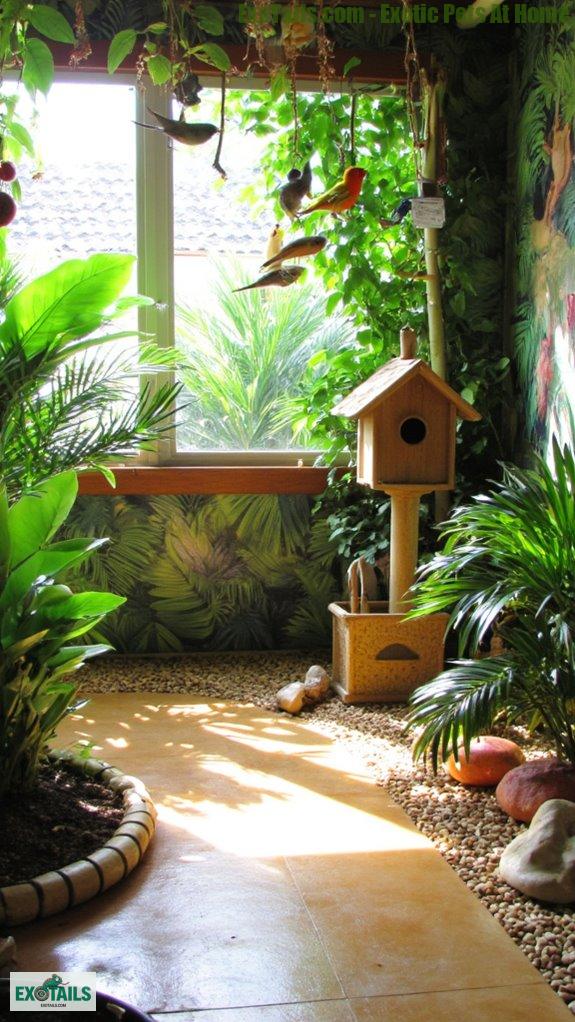
Planning for easy maintenance and access in a jungle habitat room for birds is like setting the stage for a harmonious bird performance—everyone’s got to be able to get in and out smoothly, right?
I always prioritize easy openings, tool-free fasteners, and solid maintenance schedules. They’re essential!
Trust me, smooth surfaces make cleaning protocols a breeze, and maintenance paths guarantee safe access for all.
Plus, having a regular inspection routine prevents nasty surprises. I’ve learned this from my own exotic pet adventures, which inspired my site, ExoTails.
My Axolotl at home
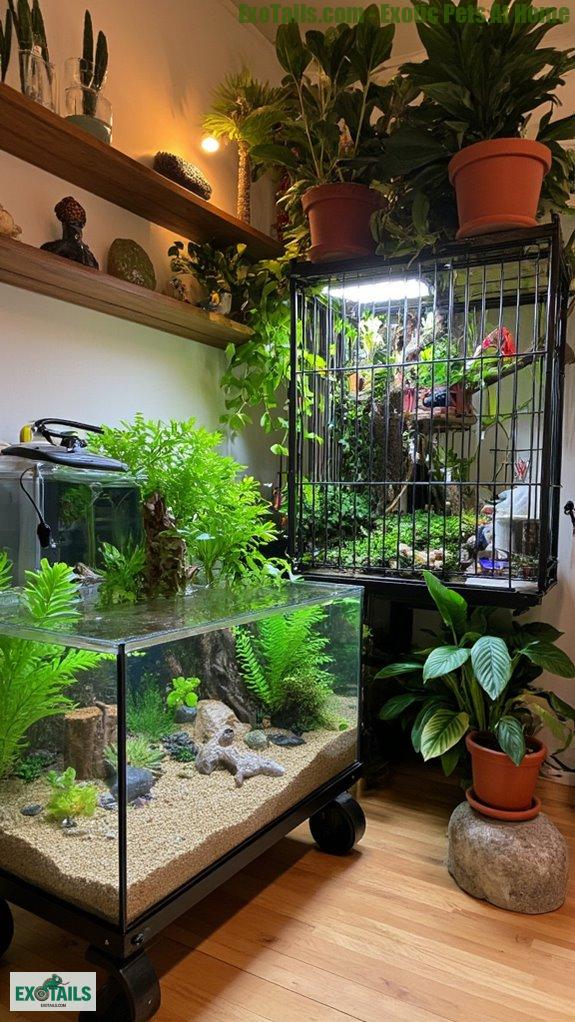
Whether you’re dreaming of an underwater wonderland or just a quirky pet that’s got a unique charm, my axolotl at home has certainly stolen the show!
With a few tweaks to my aquarium setup, I’ve created a cozy habitat that keeps my little friend happy and healthy.
Here’s what I focus on for superior axolotl care:
- Maintain a water temperature between 60-65°F.
- Use a 15-gallon tank with sand substrate.
- Provide hiding spots to reduce stress.
- Feed protein-rich foods, like bloodworms.
- Regularly check water quality to avoid toxicity.
A well-maintained environment really makes all the difference!
References
- https://hari.ca/avian-care/bird-room-design-considerations/
- https://sanctuaryfederation.org/wp-content/uploads/2017/09/birdsofprey.new-format.6.13HA.pdf
- https://hebmetalmesh.com/zoo-enclosures-bird-avairy-suitable-for-all-kinds-of-birds-hebmetalmesh/
- https://www.bbg.org/article/a_bird-friendly_garden
- https://hebmetalmesh.com/ultimate-guide-to-designing-and-building-large-bird-aviaries/
- https://www.chewy.com/education/wildlife/wild-birds/build-an-outdoor-bird-aviary
- https://billyoh.com/extra/diy-guides/important-steps-when-building-an-outdoor-bird-aviary/
- https://www.nca.uk.net/factsheets/Fact_Sheet_03.pdf
- https://sanctuaryfederation.org/wp-content/uploads/2017/09/Arboreal-Perching-BirdsJuly2013HA.pdf
- https://kb.rspca.org.au/knowledge-base/where-should-i-keep-my-birds/







